| Your browser is not supported. | ||
|
Please browse our site using any of the following options:
| ||
Complete Guide To Cooking On An Open Fire
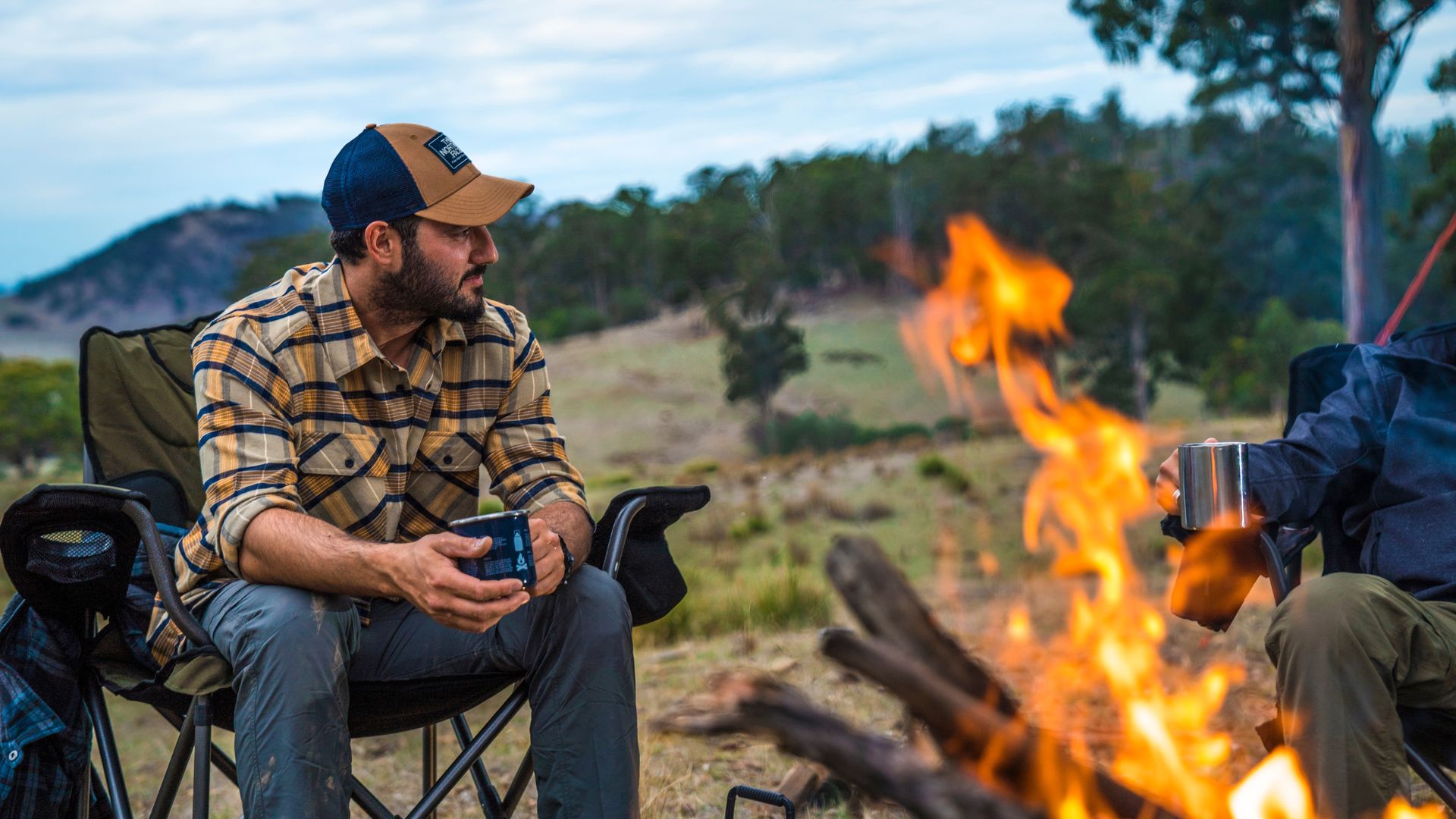
Once the tent has been set up, the sleeping bag is unrolled and the sun begins its daily descent beyond the distant horizon, it's the sound of popping and crackling over a roaring fire that is the exclamation point to any camping trip. It's the primal urge of creating a fire that has given life to humanity, a cornerstone of our existence in the unfolding storybook of mankind, and a fundamental pillar of any camping trip.
For many years, propane-fuelled camp stoves overtook open-fire cooking as the go-to choice when camping because of their flexibility, portability and simplicity. In recent times, though, campfire cooking and fire pit cooking has enjoyed something of a renaissance. This has been partly due to wood-fuelled fire pits being the only fuel source allowed at many of Australia’s most popular camping destinations, and partly because of ‘foodie culture’ highlighting the unique flavours of smoked, barbecued, roasted and grilled foods. While outdoor cooking does take some getting used to, it’s not as difficult as many would have you believe. Serving up amazing food cooked over an open campfire really comes down to having the appropriate gear, and an understanding of the basics for grilling and roasting foods over an open flame.
Here is the ultimate guide on everything you need to know about campfire cooking:
Quick Links:
- Most Commonly Asked Questions
- What Materials Should You Use When Cooking On A Fire?
- What Cooking Equipment Is Best For Campfire Cooking?
- What Cooking Utensils Are Best For Open Fire Cooking?
- How To Build An Open Fire
- Essential Tips For Cooking On A Fire
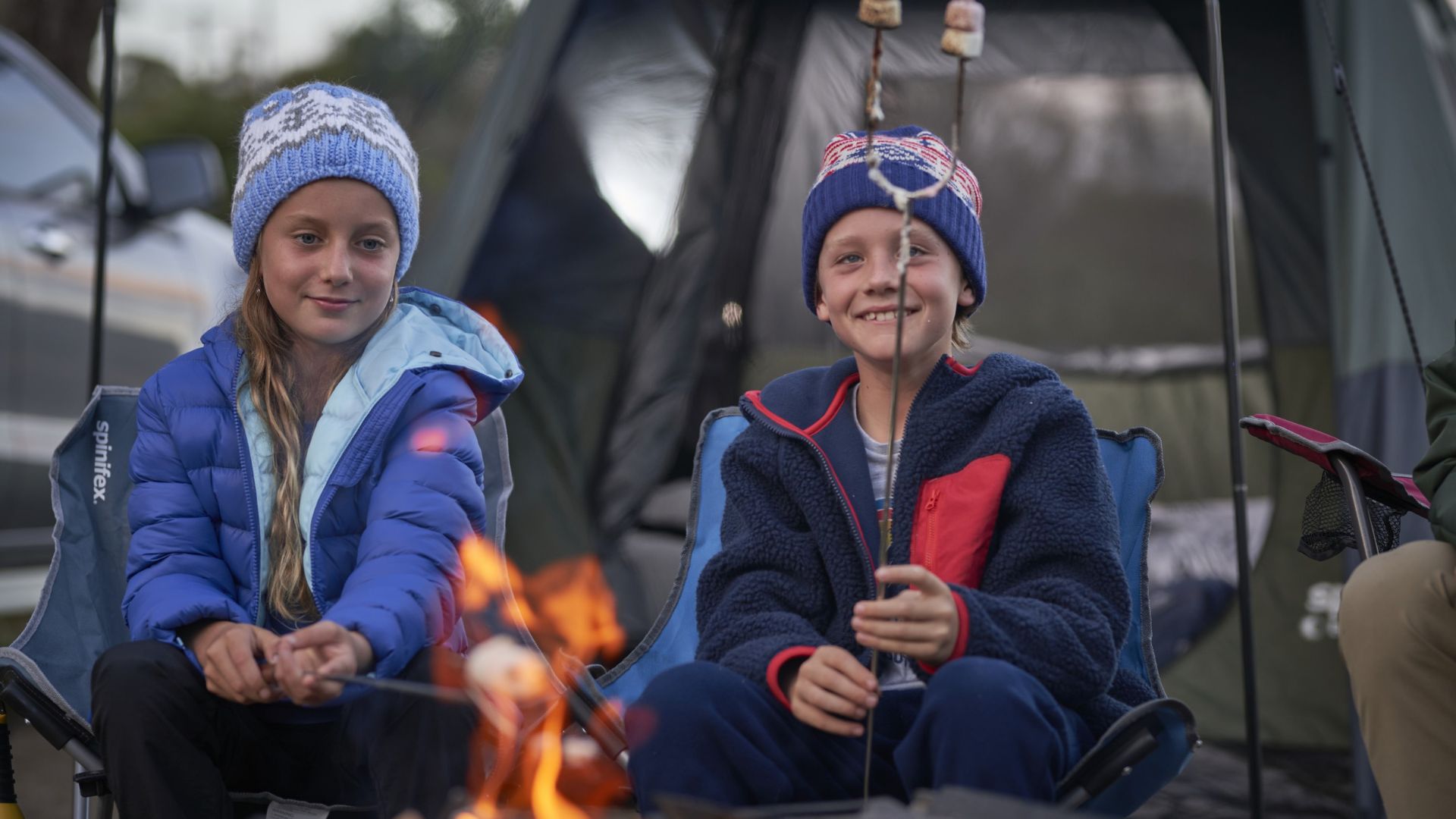
Most Commonly Asked Questions About Open Fire Cooking
When did humans use fire to cook?
According to anthropologist Richard Wrangham, it is estimated that humans began cooking with fire around two million years ago. It is believed it was the Java Man, an extinct hominin from the human lineage of Homo Erectus located in the region of Indonesia, who first began the practice of using fire to cook.
What is cooking over a fire called?
The answer to this question depends on what surface you are using. For example, cooking food attached to a rod over an open fire is called 'roasting', whereas cooking food on a grate over a fire is called 'grilling', and cooking food directly over hot coals is called 'broiling'.
Is cooking over fire healthy?
Cooking over an open fire is healthy - as long as you are using the right type of fuel source. For example, if you are fueling your fire with wood that has been contaminated by foreign substances or chemically treated, then it can give off harmful fumes when ignited. This is why it's crucial to always use the right type of fuel when doing open-fire cooking.
What can you cook over a fire?
When it comes to what you can cook over a fire, the options are limited. They can range from easy-to-make classics to the more complex such as:
- Damper on a stick
- Stews
- Snags (sausages to everyone else outside Australia)
- Pancakes
- Pizza
- Shakshuka
For more in-depth ideas, check out our ultimate guide to easy camping food ideas.
How hot is a campfire?
The average internal temperature (also known as the continuous flame region) of a campfire is around 900°C. However, you would typically be doing your cooking above the flames (also known as the thermal plume region) where the typical temperature would be around 320°C. This is why materials such as cast iron are recommended because it has a melting point of around 1127°C.
What are the different types of fire pits?
Outside of propane and LPG-fuelled camping stoves, the overwhelming majority of campfire cookers are fire pits that come with accessories like grilling grates and hotplates that enable them to double as a cooking ‘appliance’. So, as well as being handy for keeping warm in the colder weather, their versatility and all-year use make them excellent value for money.
Don’t forget to take the weight of your fire pit into consideration. Cast iron fire pits tend to weigh more than their stainless steel and aluminium counterparts but their durability is really hard to fault. As well as weight, a really important element to consider is portability. Many fire pits are designed to fold down flat and minimise the space they take up, ultimately making it easier for you to get your pit from car to campsite.
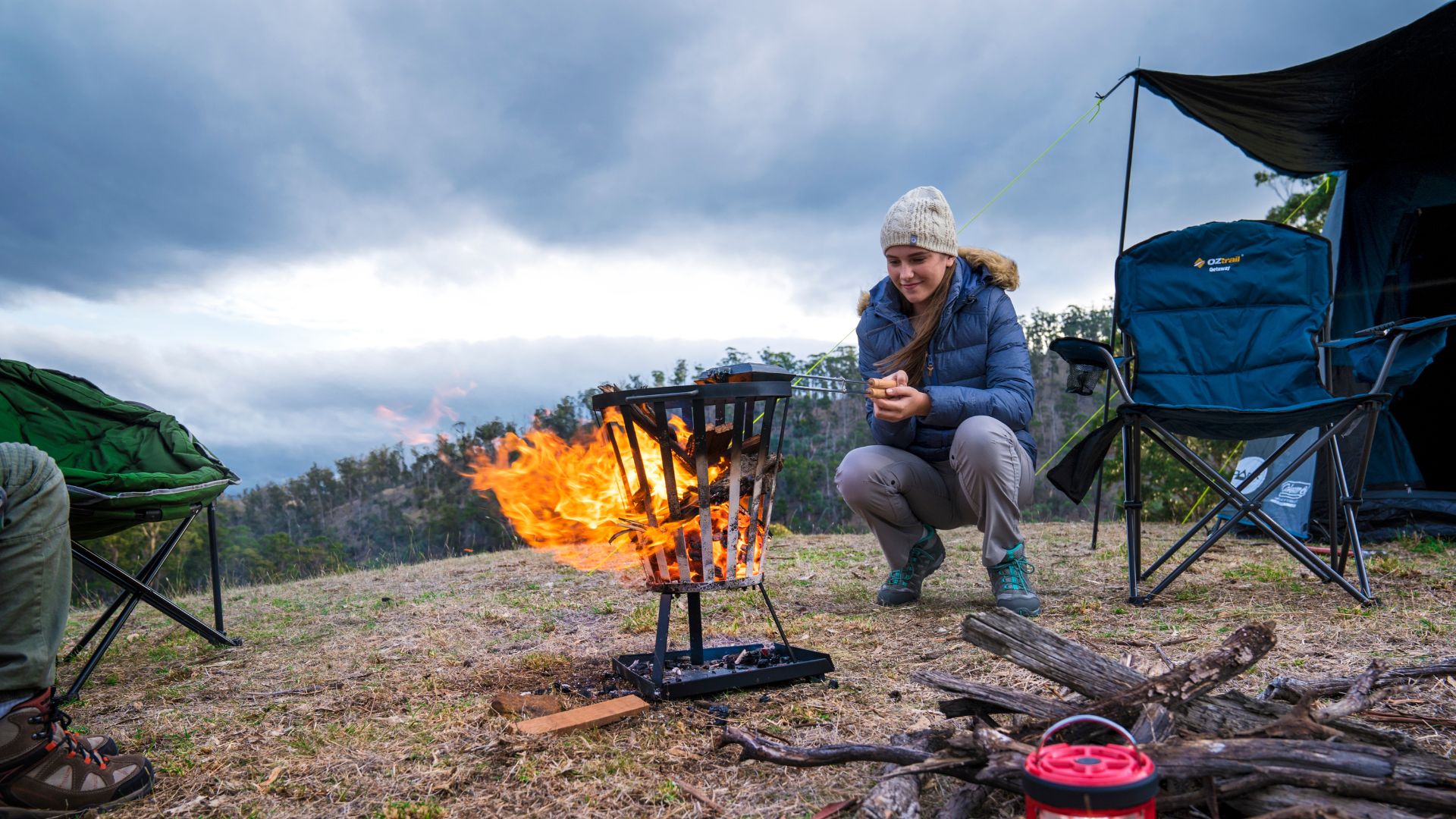
What Materials Should You Use When Cooking On A Fire?
Fire pits or fire pit grills come in three main materials: cast iron, stainless steel and aluminium. These three materials are made to withstand really hot temperatures, which means they’re ideal for campfire cooking. The type of materials that you use when cooking on an open fire makes all the difference, not just in terms of how efficiently your food will cook but also for health reasons. As mentioned before, cast iron cookware has a melting point of 1127°C, making it the ideal material for cooking over fire.
Other materials can include stainless steel with a melting point of around 1510°C and aluminium which has a melting point of around 660°C. But common sense plays a big factor here. For example, you may be using stainless steel cooking tongs - but if they have a plastic casing then that is going to melt into the fire and emit harmful toxins.
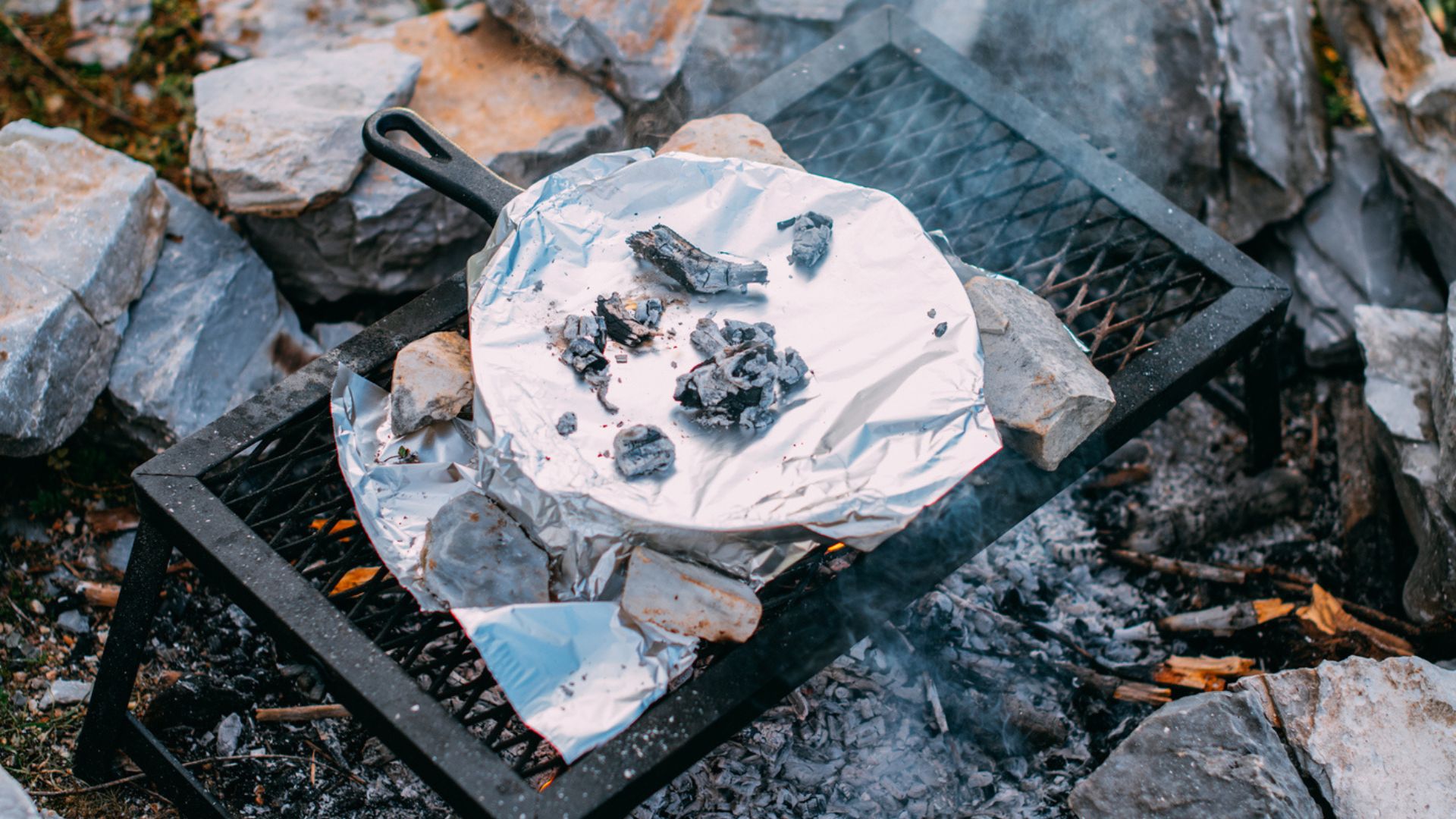
What Cooking Equipment Is Best For Campfire Cooking?
Rotisserie grill
If you are cooking for a massive group or family gathering, then a spit or rotisserie grill is going to be a sure crowd-pleaser. Slowly rotating above a roaring fire, a rotisserie is perfect for cooking a juicy and succulent chicken (or an entire pig if you want to go full medieval).
Cast iron cooking tripod
Most commonly associated with cowboys in the Wild West, a cast iron cooking tripod is a great campfire setup. It typically features a chain running down the middle which can be attached to a grate or a Dutch oven while hanging over the fire while cooking.
Grill grate
When it comes to the most conventional type of cooking equipment when making a delicious meal over a campfire, a grill grate is the preferred choice. Either attached to a stand or hanging from a cooking tripod, food is placed directly onto the grill grate which then provides that signature 'flame-grilled taste' burger joints are always going on about.
Dutch oven
Apart from just campfire cooking, a Dutch oven is one of the most versatile pieces of cooking equipment in general. This bad boy can fit so much spaghetti in it, as well as delicious dishes like steamed clams, enchiladas, garlic bread, nachos, lasagna and much more. If you want to skip a lot of the prep work but still enjoy a home-cooked meal over the campfire, then check out our pre-made camping meals guide.
Skillet
Placed on top of a grill grate or the fire itself, a cast iron skillet is the perfect choice for frying up a tender piece of steak, a fish you've caught from a nearby river or even making desserts such as fruit cobbler. Apart from having great non-stick properties, it will also conduct heat evenly throughout the surface of the skillet as well, ensuring your meal is cooked evenly.
Steel wire brush
Unless you have a lot of faith in your sponge, a stainless-steel wire brush is going to make cleaning tough cooking equipment like grill grates much easier and faster.
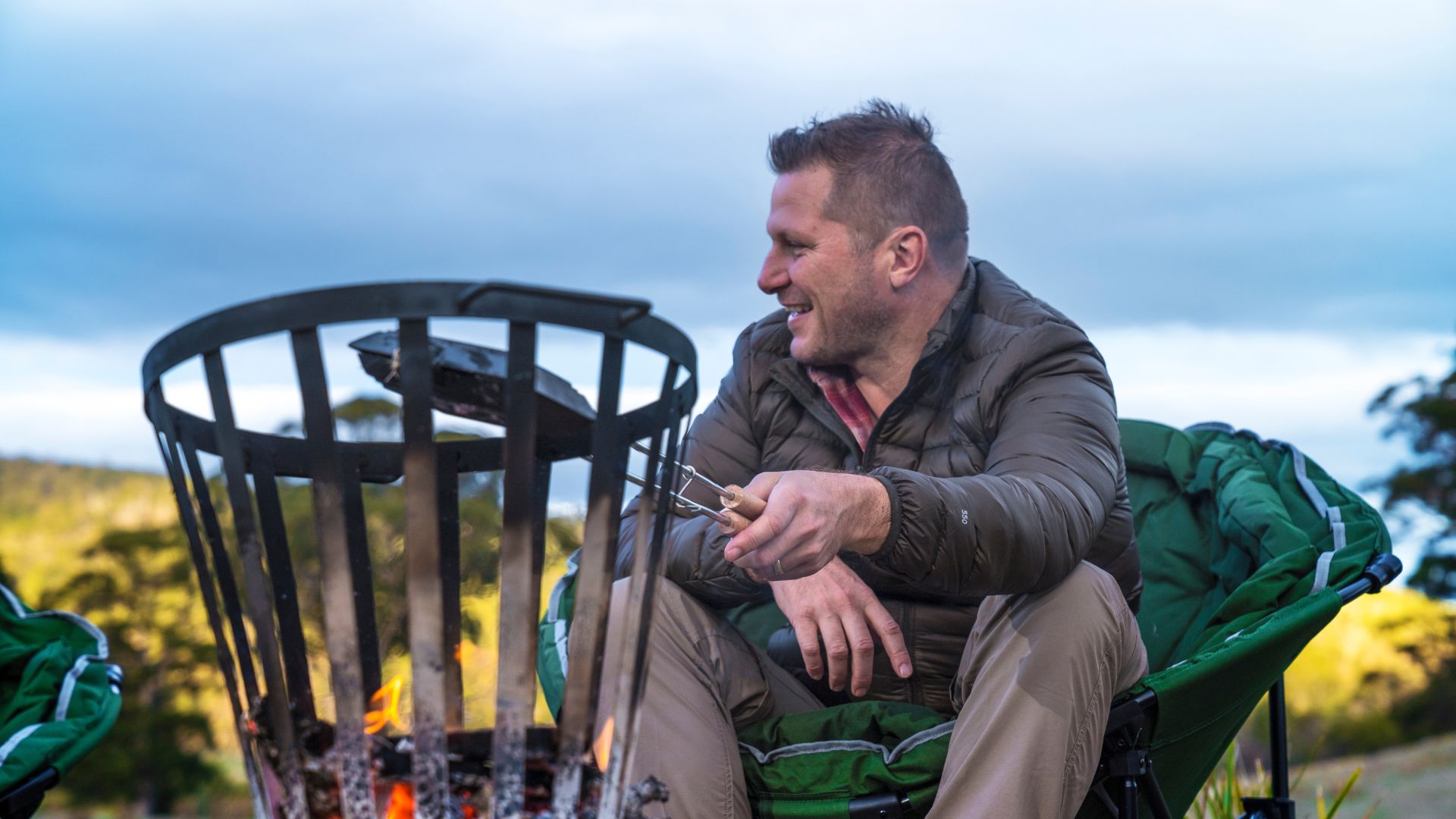
What Cooking Utensils Are Best For Open Fire Cooking?
Make sure you don’t skimp on cooking tools and fire pit accessories. You’re dealing with fire and the natural environment, so cutting corners isn’t an option. Avoid any kind of utensil or cleaning tool that’s going to be exposed to direct heat and has plastic handles. Not only will the plastic melt, but there’s a strong chance they’ll also emit toxins that could harm the local wildlife.
- Long spoon: when it comes to cookware and utensils for cooking over an open fire, a long spoon is your best friend. It will help you stir stews, soups and other meals without the risk of scratching and damaging the bottom of your Dutch oven.
- Tongs: to make sure you always get a good grip on the food you are lifting and to avoid it from falling into the fire, you can't cook over an open fire without a pair of good-quality stainless-steel tongs - just make sure they don't have a plastic casing over them.
- Cutlery set: lightweight cutlery sets have one main advantage over standard steel cutlery that you might not know: they are lighter. It may not sound that important, but lugging around a backpack with loose steel cutlery rattling around will make you think again. They are also much easier to clean, which you will probably appreciate more when it's your turn to do the dishes.
- Meat thermometer: "Is the meat cooked enough? Should this much blood be in my mouth when eating it?". Make your life easier by bringing along a digital meat thermometer. If you're cooking whole meats and the internal temperature clocks in at around 65°C, then there's no need to ask the question.
- Wire brush: A good quality wire brush is a fantastic accessory to have in your camping pack. The tough bristles make cleaning easier, saving you elbow grease and giving you more time for the fun bits of a camping holiday.
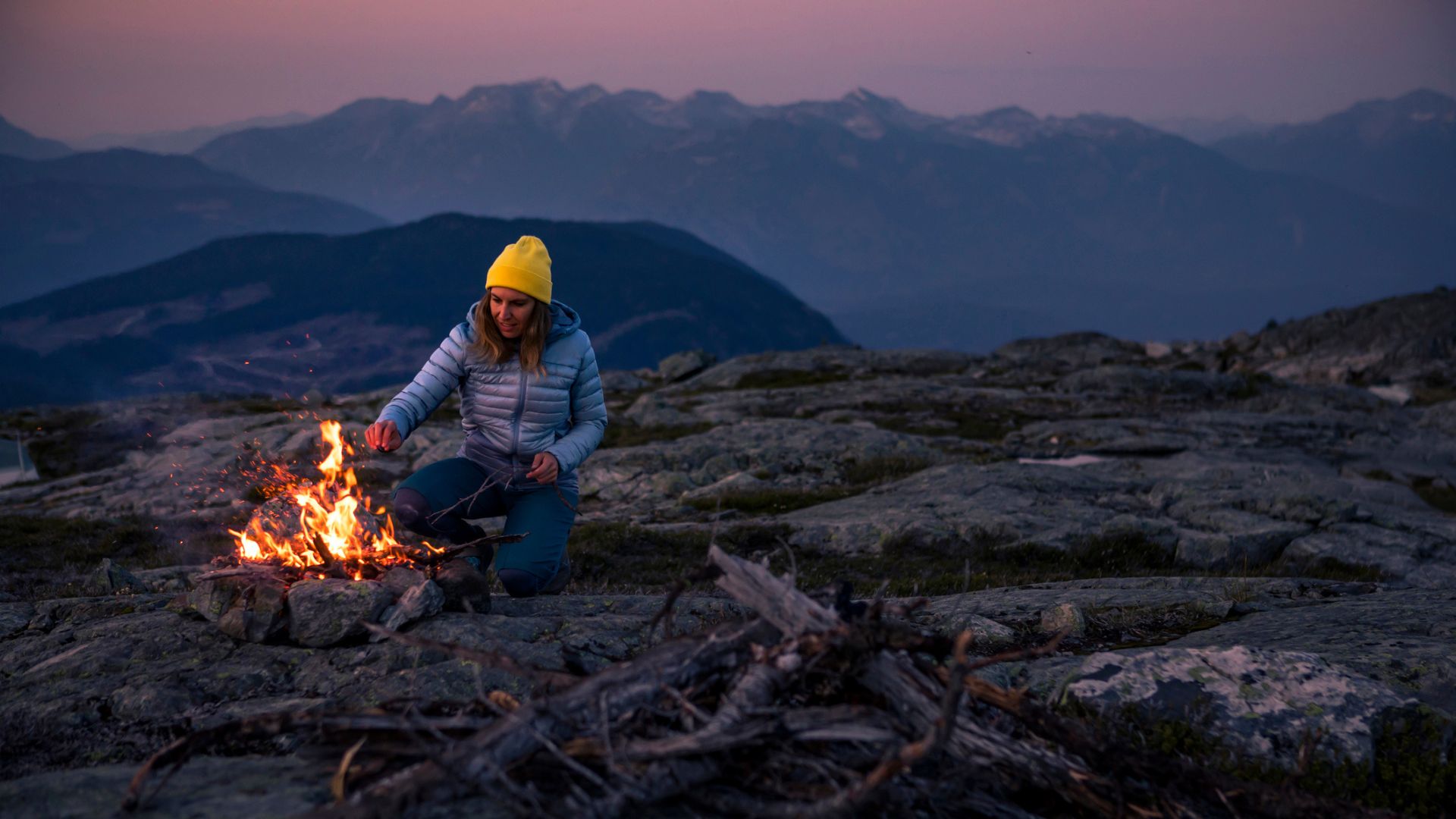
How To Build An Open Fire
It is important to ensure that safety comes first when building a campfire and choosing the right spot to build your fire is super important. If your camping spot doesn’t have dedicated space for building your fire pit, make sure the ground underneath your pit is completely clear of any debris like loose tree roots and grass. Plus, it needs some wind protection. A random gust of wind can either put your fire out or spread it around the campsite. Make sure there is nothing directly above the fire like low-hanging branches or anything that can come into direct contact with the flames as they rise. If you’ve ticked all of these boxes, and you’re following the open-fire regulations of your camping site, you’re pretty much good to go. Get more detail on setting up your campfire below:
Choose the right spot
Building a fire in a windy spot that's right next to a pile of dry leaves isn't the smartest idea. Choosing the location is the first important step to building a fire for cooking. You need to make sure there is nothing directly above the fire like low-hanging branches or anything that can come into direct contact with the flames as they rise. Also make sure that the spot is clear of things like loose tree roots, grass and dirt. If possible, use a pre-built fire pit or bring your own fire pit.
Setup kindling
Once you've found a good spot for your fire, it's time to add the kindling and tinder. This could be small pieces of dead branches, dry leaves or even crumpled-up newspaper that you've brought along. A good method is to create a base layer of dry leaves or newspaper, and then place down a few dry thin sticks in a checkerboard pattern.
Add your firewood
Make sure you have your firewood ready to go (most campsites also sell firewood) and begin igniting the tinder with a match or firestarter. As the kindling begins burning, start carefully placing the firewood in a cone shape by resting them against each other.
Add your cooking surface
Now it is time to carefully place down your cooking surface, whether it's a grill grate or a cooking tripod. It's also a good idea to always make sure you have a bucket of water near the fire in case you need to extinguish it in a hurry.
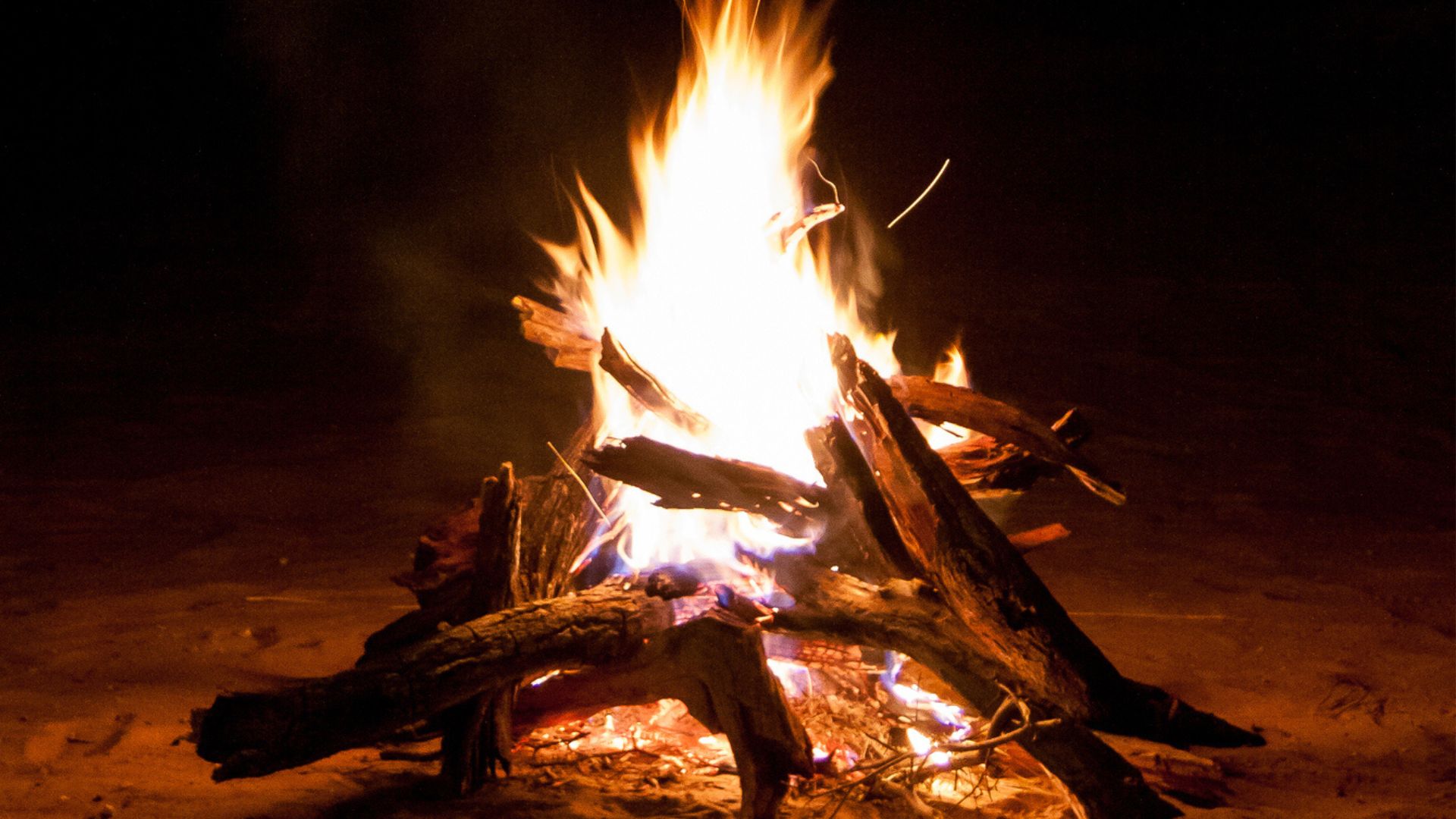
Essential Tips For Cooking On A Fire
Always use the right campfire cooking gear
Using the right campfire cooking gear is going to make your life a lot easier. As mentioned before, the last thing you want when cooking a succulent piece of steak is to get hit with the strong smell of melted plastic. This also extends to clothing as well. Make sure you are always wearing enclosed shoes around a fire as all it takes is one piece of hot ash to land between your toes to ruin your night.
The location of your campfire matters
For a variety of reasons, mainly for safety, finding the right location to start your fire is essential. Ideally, you would want to find a large flat rock to ensure the fire is contained, but if none are available, a fire pit or creating a fire inside of a circle of rocks is best. You want to make sure that the ground is completely clear of any debris and that there is a high clearance above the fire, as the last thing you need is an awning or nearby branch catching on fire. Also make sure that your fire is protected from wind, as a gust of wind may either put your fire out or spread it around the campsite.
Always use the right type of firewood
If it burns, that means it's good right? No. If you use the wrong type of wood, such as fresh or green wood, your fire will start to billow smoke everywhere and burn poorly. Wood that has been contaminated by foreign substances or chemically treated can emit harmful fumes when ignited. The ideal firewood you want to use is seasoned dry wood. Luckily it is easy to find and most campsites and petrol stations will sell packaged firewood for fire pits and camp cooking.
Never cook over an open flame
Roasting a marshmallow over an open flame is not the same as cooking a piece of meat over an open flame. Without using a cooking surface like a grill grate, your food will end up burnt on the outside and uncooked on the inside. Unless you want to spend most of your camping trip hating life while squatting over a latrine, then make sure you never cook your food over an open flame.
Watch your cooking times
Remember that you are cooking with fire and not an easily controlled induction stove. Because more heat is being used in the cooking process, you will have to factor in what is called 'carryover cooking'. Without going too deep into the complexities of thermodynamics, carryover cooking is when cooked food starts to equilibrate under its own retained heat. Basically: hot food stays hot longer, which means that perfectly cooked fish will continue cooking and start to dry out before you can tuck into it. To avoid this, simply take your food off of the fire a few minutes earlier than you normally would.
Clean up and maintenance of your fire pit and camp cooking equipment
When choosing a fire pit, it’s important to check out how easy they are to clean, and the kind of maintenance required to keep them in good nick between camping trips. To clean your camp grill while in The Great Outdoors, remove the grates and scrub the underside with your wire brush. Using non-toxic wilderness detergent, wash the outside of the grill, then rinse and dry thoroughly.
Practice At Home Before Your Trip
It’s a good idea to use your smoker or BBQ a few times at home before heading off so you’re familiar with its cooking times and quirks. Additionally, our guide to easy camping food ideas contains plenty of inspiration for awesome meals you can enjoy on your next camping trip and plan out before you go bush.
Whether you are camping alone or with friends, very few moments in life can match the feeling of being huddled around a warm fire while the smell of delicious food fills the air. Make sure you follow the advice given to ensure that cooking on a fire is a celebratory experience that creates a lasting memory you can cherish forever - and not an example of what not to do.
Enjoy Delicious Meals Cooked on the Campfire on Your Next Camping Adventure
As any fisho will tell you, there’s nothing that compares to the taste, satisfaction and freshness of cooking that day’s catch over an open campfire. For countless campers, starting the day off with bacon and eggs cooked on a cast iron skillet, or doing some sausages, or chicken fillets or steaks with damper in the evening, and then toasting marshmallows with the kids before bed is part of what makes camping so much fun. If you’ve adopted a plant-based lifestyle, campfire cooking also adds those unmistakable flame-grilled flavours to delicious vegetables and any vegan meals.
Whatever your food habits, there’s nothing like finishing a day in the great outdoors with a delicious, campfire-cooked meal; comfy chair and storytelling with family and friends while enjoying the beauty of the setting sun. Now that you know how to start a fire, the correct way when cooking on a fire and tips to keep in mind, make sure you have everything else you need for your next outdoor adventure by exploring our camping and hiking range. Shop camp cooking essentials including camping tableware and camp cookware and utensils to make cooking fun and easy.
For more helpful tips and exciting destinations across Australia, make sure you check out our Adventure Centre, and find more helpful articles such as: